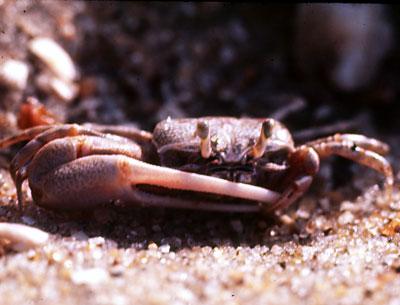Nature Notes: Cold-Blooded Crabs

In less than two months it will be winter. Fall is the season for harvest and storage, in preparation for the cold months ahead. Very few of us maintain root cellars these days; we depend upon supermarkets and mom-and-pops to “store” our vittles. But in nature, October is a busy time. Those creatures that stay on to brave the sleet and snow are in full preparation.
In my yard the non-migratory bluejays have been hiding acorns here and there for two weeks now. Gray squirrels, which also remain active all winter, are doing the same. How these cachers remember where they put things is beyond me, as I have a very hard time trying to remember where I put away much larger objects, and sometime I forget entirely. I guess if my life depended on it, I would not forget.
Even the hibernators and semi-hibernators among the local mammals store up food. Chipmunks are notorious for putting away edibles in their hibernaculae, even providing special chambers for foodstuffs. They occasionally wake up during the long winter’s nap and want a bite to eat and don’t want to leave their cozy retreat to look for it.
White-footed mice act similarly. They are more likely to snooze away in your house or outbuilding, or in a birdhouse or tree nest, than underground. Beavers are vegans, they keep a supply of greens in their lodges. Bats hang around for most of the winter and go hungry.
But what about the crabs? They don’t migrate. The cold might kill them dead, especially if they freeze. Well, at least, all of our inshore crabs — the blue, the lady, the mud, the fiddler, the marsh, the spider — are in a salt water environment to begin with, and salt water is the last of the bathing liquids to freeze. Crabs are also poikilothermic, that is, cold-blooded. They don’t have to keep their body temperatures up, as long as they don’t let them drop below freezing.
Fiddlers and marsh crabs that occupy the spartina peats and sandy edges of salt marshes retreat into their peaty holes and go to sleep. The holes in the sand are filled in and will remain that way until the warmth of spring in April wakes their dwellers up and urges them to unseal their winter quarters. At such time, a human observer will notice little mounds of pre-digested dirtballs at the entrance of each round hole.
Marsh crabs are scarcer and larger. I’ve only seen a few in my lifetime, in the marshes at Scallop Pond in North Sea. However, in the last few years, Nicole Maher of the Nature Conservancy, who is studying the change in elevations of salt marshes here and there on Long Island in relation to rising sea level, has found quite a few of them in the marshes of Accabonac Harbor. They are secretive and not as gregarious as fiddlers and have much larger holes. They utilize the cavernous nature of the peat layer to survive and stay cool in the winter.
Cancer crabs, the large ocean reddish ones, stay active all winter, as the bottom of the ocean never approaches freezing at this latitude. But the famous blue crab, Callinectes sapidus, which translates appropriately into beautiful-swimming-savory crab, and its cousin, the lady crab, also a swimmer, and an infamous biter of clamming toes, become dormant, digging into the sands and silty bottom sediments the way diamond-back terrapins and eels do, very often in the very same neighborhoods.
Crab biologists in the Chesapeake Bay, which produces 50 percent of the annual blue-claw crab landings, have been pulling dredges through these sediments systematically during the winter since the early 1990s. They have discovered that it is a good method for gauging the crab population-to-be, come spring.
Female blue crabs, the ones with the wide “telson” on the underside of the shell, are the last to go under as they first have to attend to reproduction, some of the steps of which also resemble that in turtles. The males copulate with the females (at such time crabbers that catch them call them “doubles,” the males on top, females on the bottom), but the sperm is kept in storage until November, by which time the females have moved to saltier water, closer to the mouth of the estuary. They can store viable sperm for up to a year, in the way that many females turtles can. The fertilized eggs hatch into swimming larvae which occupy the water column. The females are free to dig under to spend the winter in a quiescent state.
What about spider crabs? They move into deeper water and like to feed on bay scallops. Better catch those remaining male blue-claws while the crabbing’s good and they’re still above the bottom, not into it.
